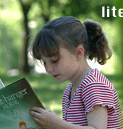Readers need to learn various types of literacy knowledge.
These were identified in the model of reading. These include
a knowledge of the conventions for writing and reading the
units in text (words, sentences, paragraphs and longer text),
a knowledge of how to act on the units in order to comprehend
them (the reading actions or strategies) and the oral language
knowledge necessary to support and scaffold the reading activity.
The pathway through the content is shown in the following
diagram.
Students either read aloud or read silently. When readers
read aloud (that is, engage in 'oral reading'), we are able
to see what they are doing while they read and intervene if
necessary. There are five types of oral reading activity.
| types of oral reading activity |
| interactive reading aloud |
solo reading aloud |
paired reading |
shared reading |
multiple or repeated readings |
| learn and practise particular reading actions |
practise reading aloud, possibly onto an audio tape |
read text aloud with another person |
read plays, novels, etc, with other readers and |
read the same text more than once |
All of the activities are important.
When readers read silently, it is more difficult to intervene
while the reader reads. However, as we sill show, we can engage
in interactive reading silently.
In the following sections we target interactive reading aloud
and silently.

